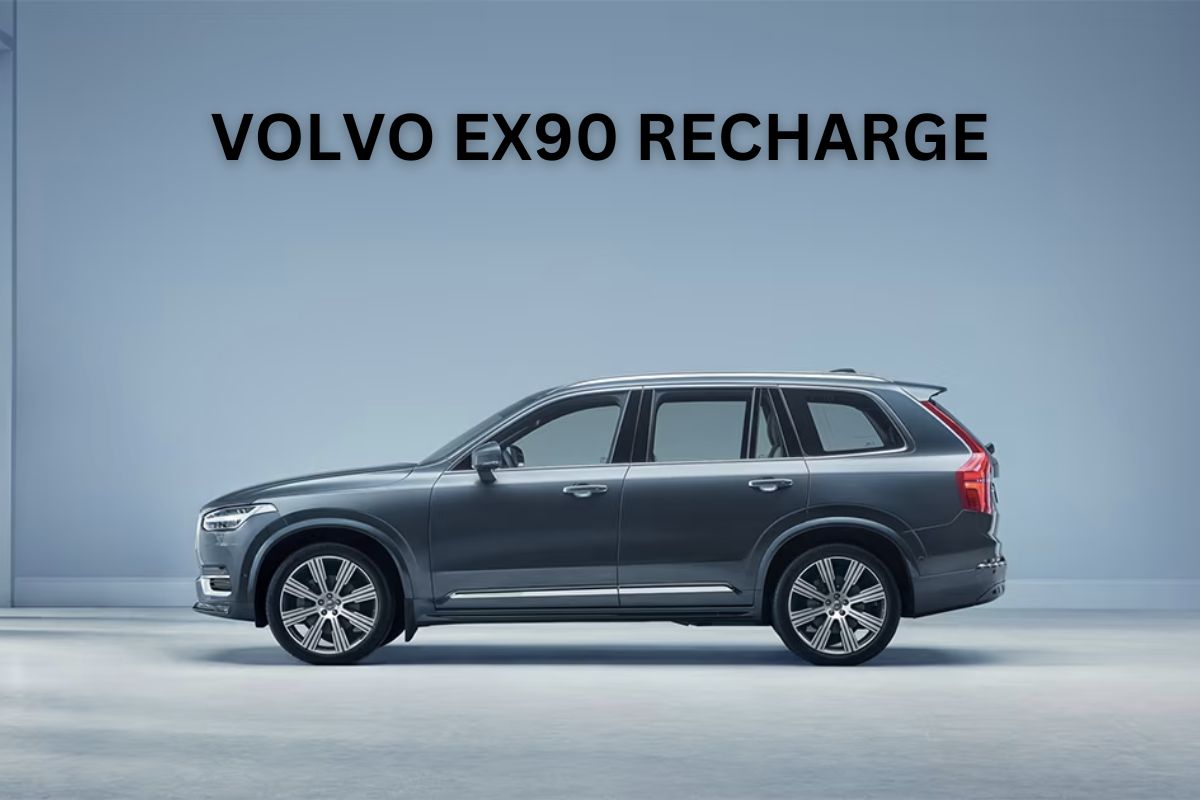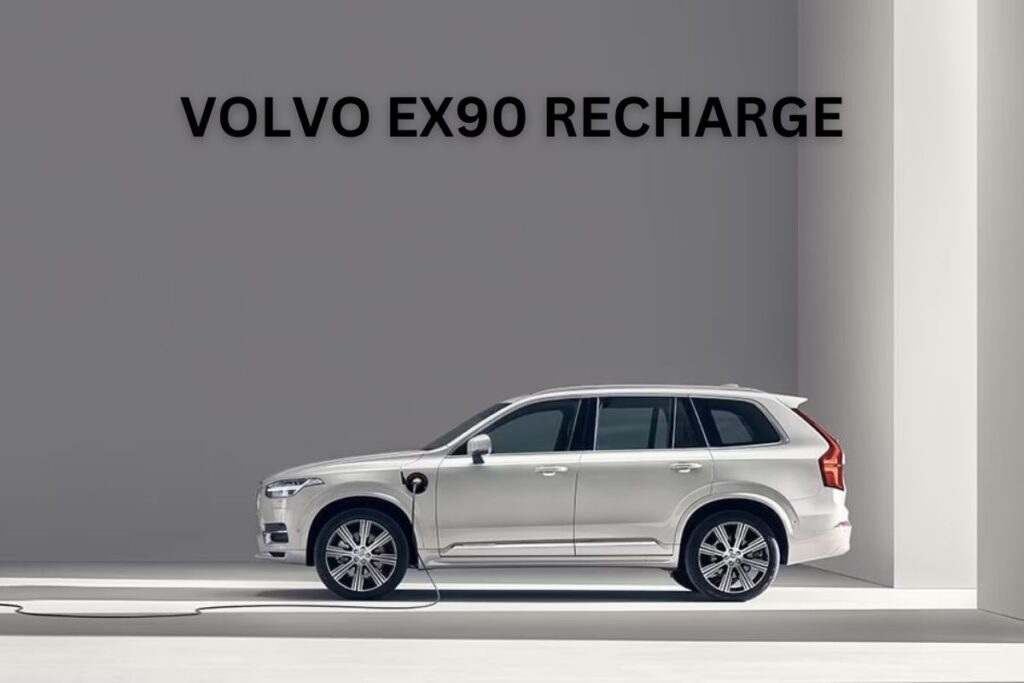VOLVO EX90 RECHARGE – Where can I find a new Volvo? If that’s the case, consider yourself fortunate. This blog contains up-to-current details on the VOLVO EX90, including its latest pricing in India, launch date, full specifications, available colours, and booking choices. In addition, the blog hosts commentary from those who have owned or driven a VOLVO EX90. Whether you’re a Volvo novice or an old pro, you’ll want to read our blog for the newest updates on the Volvo EX90.
Volvo Cars are continuing its transition to electric vehicles, with the 2023 debut of its flagship electric SUV, the Volvo EX90 Recharge. The Volvo EX90 Recharge electric SUV is a plug-in hybrid variant of the Volvo XC90, the company’s current flagship SUV. To be the company’s flagship vehicle, the Volvo EX90 Recharge electric SUV will ideally be bigger than the XC90. Volvo plans to transition to an all-electric lineup by 2024.
VOLVO EX90 RECHARGE 2023
Shortly, the Volvo Ex90 will make its highly anticipated debut in the Indian market. In February 2020, reservations will be taken for the car, whose release date is yet unknown but which is rumoured to come with a high price tag. There is a 16-week minimum wait period to reserve a VOLVO EX90. There will be four available colours for the vehicle: Crystal Black Pearl Platinum Metallic, Solar Orange Metallic, Electric Blue Metallic, and Inscription White.
The EX90 Recharge electric SUV will also serve as the world premiere of Volvo’s latest LiDAR technology, which consists of eight cameras, five radars, and sixteen ultrasonic sensors. Eventually, this updated capability will become standard on all brand-new Volvos sold in India. The Greely-owned Scandinavian automaker boasts that its LiDAR technology can spot pedestrians up to 250 metres away and something as little and dark as a tyre on a black road 120 metres ahead, even at highway speeds. The new, internally developed technology will serve as the brains of the vehicle, processing data in real-time to detect and avoid potential dangers.
VOLVO XC90 RECHARGE Details 2023
| Name of the Car Company | Volvo |
| Car Name | Volvo EX90 Recharge |
| Article about | VOLVO EX90 RECHARGE Price in India 2023, Launch Date, Full Specifications, Features, Colours, Booking, Waiting Time, Reviews |
| Category | Automobile News |
| website | www.volvocars.com |
VOLVO EX90 RECHARGE Launch date
The Volvo EX90 is a seven-seat crossover vehicle. In March of 2024, Volvo plans to introduce the EX90 to the Indian market. Volvo EX90 will compete with the likes of the Phantom, Aventador, and Ghost. You can count on rates to begin at around 1.50 Crore. The Swedish automaker is continuing its transition to electric vehicles and will soon unveil its flagship electric SUV, the Volvo EX90 Recharge, set to debut in 2023. For the 2023 model year, this subcompact luxury crossover SUV is receiving a redesign, so that’s exciting. Volvo has announced that both the all-electric XC40 Recharge and the mild-hybrid XC40 will receive updates for this generation.
VOLVO EX90 RECHARGE Price In India 2023
The Volvo EX90 may be had for a minimum of Rs. 1.50 Cr. The Volvo EX90 is available in two different trim levels, the more affordable B6 Inscription 7-Seater and the more luxurious T8 Twin Inscription 7-Seater, the latter of which can be purchased for approximately Rs. 1.50 Cr.
| Variant | Ex-Showroom Price | |
|---|---|---|
| UPCOMINGEX90Automatic, Electric | Rs.1.50 Cr |
Colours
Volvo XC90 is available in 9 different Colours – Crystal White Pearl Metallic, Luminous Sand Metallic, Bright Silver Metallic, Onyx Black, Twilight Bronze Metallic, Ice White, Savile Grey Metallic, Osmium Grey Metallic and Electric Silver Metallic.

VOLVO EX90 RECHARGE Features
Joachim de Verdier, Volvo’s head of Safe Vehicle Automation, has stated that the company considers the EX90 to be the safest car the company has ever produced. Currently, we are combining what we know about the outside world with what we know about drivers’ attention systems in greater depth. When all of our sensors, software and processing power are working together, they form a protective shield around you, and you won’t even notice it’s there until the moment you need it.
| Power Steering | Yes |
| Power Windows Front | Yes |
| Anti-Lock Braking System | Yes |
| Air Conditioner | Yes |
| Driver Airbag | Yes |
| Passenger Airbag | Yes |
| Fog Lights – Front | Yes |
| Alloy Wheels | Yes |
| Multi-function Steering Wheel | Yes |
VOLVO EX90 Engine
The new flagship SUV from Volvo is powered by a 48-volt electric motor and a 2.0-litre turbo-petrol mild-hybrid engine (300PS/420Nm of torque). Four-wheel drive is powered by an eight-speed automatic transmission.
VOLVO EX90 Safety
Seven airbags, radar-based adaptive cruise control, lane keeping assist, front and rear collision avoidance, city braking system feature, blind spot detection with cross-traffic alert, and run-off road protection are just some of the safety features found in the new EX90.
VOLVO EX90 Connectivity
The next Volvo EX90 electric SUV will feature improved ADAS capabilities thanks to the incorporation of LiDAR technology. There will also be a system of cameras and sensors put in the car that monitors the driver’s eye movement to determine how much attention they are paying to the road. If the driver nods off while operating the vehicle, the system will begin with a gentle prod and increase in intensity if necessary. In case such a circumstance ever occurs, the system can immediately halt and initiate a support request.
VOLVO EX90 RECHARGE Specification
Six different colours, including green, red, silver grey metallic, black S60 Polestar Headlight Edition with chrome accents on body side trim and roof rails, orange S60 Polestar Headlight Edition with chrome accents on body side trim and roof rails, and white S60 Polestar Headlight Edition with chrome accents on the front grille, side mirrors, and wheel arch extensions, will be available for the new Volvo Ex90 recharge. Recharging times for the new Volvo Ex90 in India are yet unknown but are expected to be lengthy.
| ARAI Mileage | 36.0 km/l |
| Fuel Type | Petrol |
| Engine Displacement (cc) | 1969 |
| No. of cylinder | 4 |
| Maximum Power (bhp@rpm) | 400bhp |
| Maximum Torque (nm@rpm) | 640Nm@1740rpm |
| Seating Capacity | 4, 7 |
| Transmission Type | Automatic |
| Boot Space (Litres) | 300 |
| Fuel Tank Capacity | 68.0 |
| Body Type | Hybrid |
| Ground Clearance Unladen | 238 mm |
Engine and Transmission
| Battery Capacity | 48V |
| Displacement (cc) | 1969 |
| Max Power | 300hp |
| Max Torque | 420nm |
| No. of cylinder | 4 |
| Valves Per Cylinder | 4 |
| TransmissionType | Automatic |
| Gear Box | 8-Speed |
| Mild Hybrid | |
| Drive Type | AWD |
Fuel & Performance
| Fuel Type | Petrol |
| Petrol Mileage (ARAI) | 17.2 |
| Emission Norm Compliance | BS VI |
Suspension, Steering & Brakes
| Front Suspension | Air Suspension |
| Rear Suspension | Air Suspension |
| Steering Type | Power |
| Steering Column | Adjustable |
| Front Brake Type | ventilated disc |
| Rear Brake Type | ventilated disc |
Dimensions & Capacity
| Seating Capacity | 7 |
| Ground Clearance (Laden) | 267mm |
| No of Doors | 5 |
Competitors
Volvo XC90 rivals in these cars like BMW X5, and Lexus 450h.
Waiting Time
By 2023, Volvo plans to introduce the all-new EX90 to the Indian market. Please reserve your purchase of one of these vehicles as soon as possible. The waiting period is anticipated to be no more than six months, and the vehicle will be available in your choice of three colours: blue, grey, or white. The Volvo EX90, powered by a 3-litre diesel engine and with an all-wheel drive system, will undoubtedly set a new standard for luxury SUVs. People appear to be pleased with the vehicle, based on early ratings and evaluations, and hopeful for its future potential. When you see the new Volvo EX90 in India, expect to fall in love.
How to Book Volvo EX90?
With the upcoming 2023 arrival of the Volvo EX90 in India, now is the time to secure your vehicle of choice. To help you make a wise purchase, we have collected the most up-to-date details regarding the vehicle. You may have to wait a few months for your automobile to arrive, depending on your location, but rest assured that the wait will be worthwhile. The car’s complete technical specifications have also been made public, and it will be offered in five different colours: black (Enigma), red (Vincente), grey (Mistero), yellow (Genio), white (Audace), and blue (Infinito). All we hear are raves about this car, and we can’t wait to get our hands on one.
- First of all visit Volvo’s official website www.volvocars.com
- And select your model then select your transmission type.
- Select your favourite variants on your car.
- Select your favourite colour for your car.
- And then pay your booking amount of some.
Conclusions
In terms of style, functionality, and comfort, this vehicle is unparalleled. This vehicle gets fantastic gas mileage. The cost of maintenance is high enough to be a problem, but it’s not outrageous compared to other vehicles in the same price range. The security is excellent as well. As a result, in general, it’s a fine option for those kinds of markets. The vehicle’s comfort level falls short of what the firm promised. Likewise, they’re having issues while driving. The automobile hasn’t gone more than 2,000 kilometres, but already the multipurpose sensors are indicating that engine performance may suffer beyond that. Just when I thought I had everything fixed, the sign reappeared two weeks later.
Only the fitted wool upholstery and the lack of leather in the luxury seven-seater set it apart from the mild hybrid version on the inside. Like the current SUV, it has a panoramic sunroof up top, connectivity to an infotainment system based on Google’s Android operating system, a Bowers & Wilkins sound system, air suspension, a head-up display, a crystal gear shifter, and a digital driver’s display.
Frequently Asked Questions
What is the VOLVO EX90 RECHARGE Price in India 2023?
Recharge is the top model of Volvo XC90 2023 and the most recent price for a Volvo XC90 2023 Recharge is ₹ 1.50 Cr.
What is the price of Va olvo 7 seater?
The Volvo XC90 is a seven-seater SUV that costs ₹ 1.50 Cr. lakh to purchase. The car is offered in two versions: Automatic and 1969 cc engine. A Ground Clearance of 238 mm, a Kerb Weight of 2962 kg, and a Boot space of 709 litres are some of the other important features of the XC90.
What Is the Volvo recharge a hybrid?
A conventional charging cable Mode 2 is included with your Volvo Recharge plug-in hybrid, which meets rigorous electrical safety standards. This 7 m cable allows up to 1.4–2.3 kW charging via a household socket, and it is available in three versions (6A, 8A, or 10A).
Does Volvo Recharge use gas?
Pure Electric mode, Power mode, and hybrid mode are all available with our Recharge Plug-in Hybrids, giving you complete driving autonomy while reducing tailpipe emissions.
Read More:

